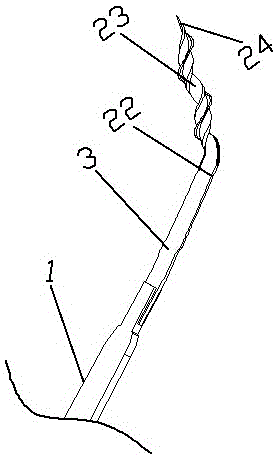Cutter for uterus resection operation
A hysterectomy and knife technology, applied in the field of medical devices, can solve the problems of heavy workload for doctors, long time required, poor results, etc., and achieve the effect of improving surgical efficiency, reducing pain, and having a reasonable structure
- Summary
- Abstract
- Description
- Claims
- Application Information
AI Technical Summary
Problems solved by technology
Method used
Image
Examples
Embodiment 1
[0023] as attached figure 1 The shown cutter is used for hysterectomy, and includes a knife handle 1 and a sheet-shaped cutting knife 2 installed on the knife handle 1. The cutting knife 2 includes a knife back 21 and a knife extending outward from the knife back 21 for cutting The two blades 22 of the uterus, the blades 22 are spirally arranged along the central axis forming an angle α with the vertical axis of the knife handle 1, the angle α is an obtuse angle, which is 135° in this embodiment, and The helical angle of the blades 22 gradually decreases from the top of the tool to one end of the handle 1; adjacent blades 22 form a longitudinal channel 23 with a smooth arc-shaped surface leading to the direction of the handle 1 . The blade 2 forms a breakout tip 24 at the top of the knife where the tip of the blade portion 22 converges into a point.
Embodiment 2
[0025] as attached figure 2 The shown cutter for hysterectomy comprises a knife handle 1, a connecting neck mounted on the knife handle 2 and a sheet cutter 2 integrated with the connecting neck. The cutting knife 2 includes a knife back 21 and a knife back 21 are three blades 22 extending outwards for cutting the uterus. The blades 22 are arranged helically along the central axis at an angle α of 110° with the vertical axis of the knife handle 1, and the blades 22 The helical angle gradually decreases from the top of the tool to one end of the handle 1; a longitudinal channel 23 leading to the direction of the handle 1 is formed between adjacent blades 22, and its width gradually decreases from the top of the tool to one end of the handle 1. increase. The blade 2 forms a breakout tip 24 at the top of the knife where the tip of the blade portion 22 converges into a point.
Embodiment 3
[0027] as attached image 3 The shown cutter for hysterectomy comprises a knife handle 1, a connecting neck mounted on the knife handle 2 and a sheet cutter 2 integrated with the connecting neck. The cutting knife 2 includes a knife back 21 and a knife back 21, three blades 22 extending outwards for cutting the uterus. The blades 22 are spirally arranged along the central axis forming an angle α with the vertical axis of the knife handle 1, and the angle α is 150°. And the helix angle of the blade portion 22 gradually decreases from the top of the tool to one end of the handle 1; between adjacent blade portions 22, a longitudinal channel 23 with a smooth arc-shaped channel surface leading to the direction of the handle 1 is formed, Its width gradually increases from the top of the cutter to one end of the handle 1 . The blade 2 forms a breakout tip 24 at the top of the knife where the tip of the blade portion 22 converges into a point.
[0028] When using, it is necessary to...
PUM
 Login to View More
Login to View More Abstract
Description
Claims
Application Information
 Login to View More
Login to View More - R&D
- Intellectual Property
- Life Sciences
- Materials
- Tech Scout
- Unparalleled Data Quality
- Higher Quality Content
- 60% Fewer Hallucinations
Browse by: Latest US Patents, China's latest patents, Technical Efficacy Thesaurus, Application Domain, Technology Topic, Popular Technical Reports.
© 2025 PatSnap. All rights reserved.Legal|Privacy policy|Modern Slavery Act Transparency Statement|Sitemap|About US| Contact US: help@patsnap.com



